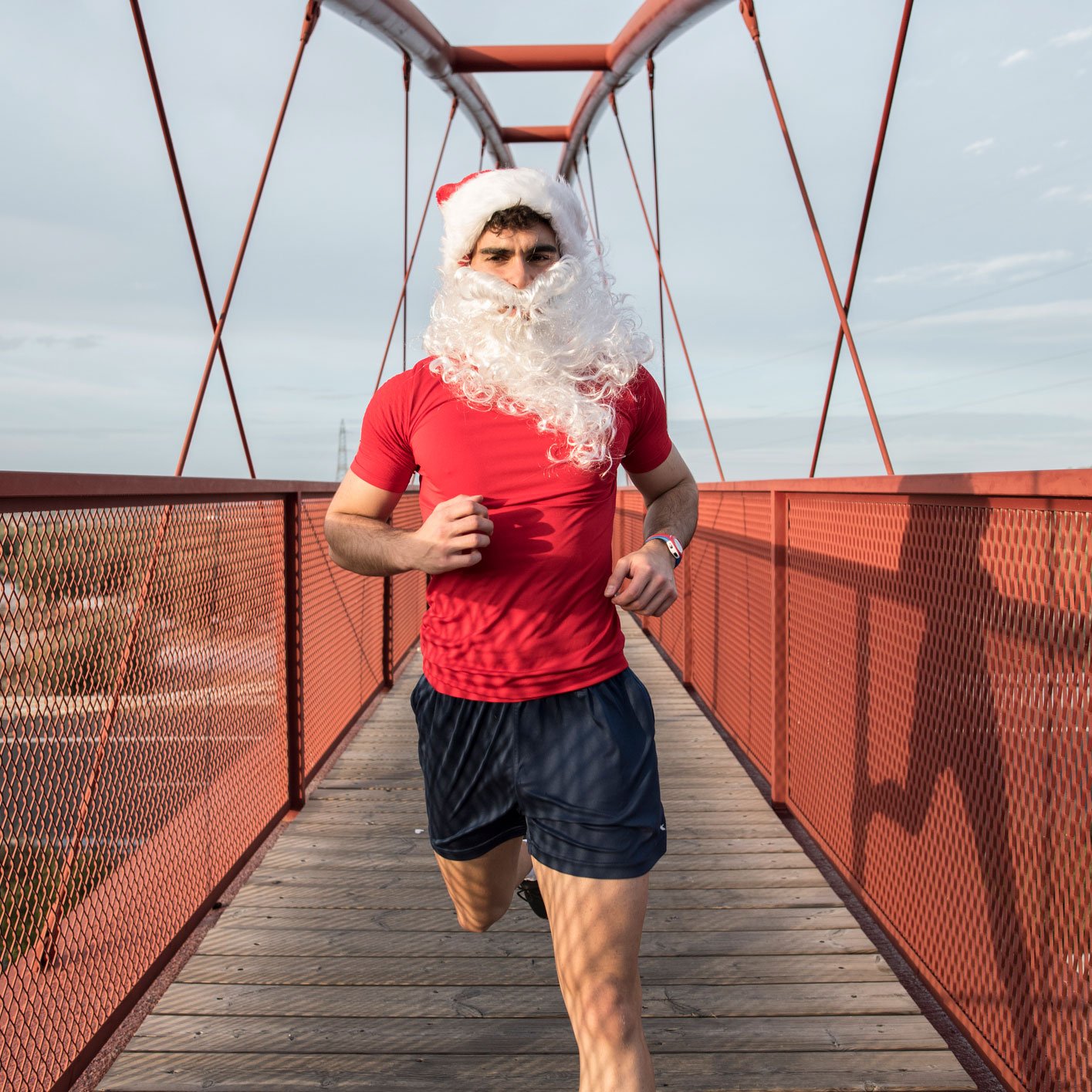
The goal of the Mishock Physical Therapy Holiday Home Exercise program is to promote the development of the individual’s ability to become strong in fundamental movement patterns (relative maximum strength) that are critical to improving function and preventing injury. The scientifically based program trains the body’s major muscle groups by focusing on the core, upper, and lower body strength through fundamental movement patterns. Once the necessary “relative maximum strength” is developed, the individual is ready to progress to other advanced training methods using free weights or other complex exercise methods.
Tri-phasic muscle contraction training
The program uses a tri-phasic muscle contraction (concentric, eccentric, and isometric) training method. Our body uses these three contraction types as a regular part of functional movement in; work, recreation, and sport. Concentric muscle contraction is muscle shortening. Eccentric contraction (negative) is a muscle lengthening contraction. During the eccentric contraction, the movement is slow to a count of 5 seconds. An isometric contraction is a contraction of the muscle without joint movement. During the exercise, the isometric contraction is held for 5 seconds.
Circuit Training
The Mishock Physical Therapy Program should be performed in a circuit (one exercise after the other) fashion with no breaks between exercises. The continuous course will allow for a cardiovascular workout by increasing the heart rate. Complete the circuit 2-3 times. For the novice exerciser or the deconditioned individual, modifications could be made in the program to meet the individual’s needs. Before beginning any exercise program, consult with your physician or health care provider.
Mishock Physical Therapy’s Holiday Holiday Home Exercise Program
Squat
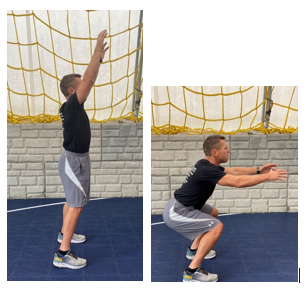
Why this exercise?
The squat is a compound, full-body exercise that is an essential fundamental movement pattern. This multi-joint movement exercise trains the lower back, hips (erector spinae, gluteus medius/maximus muscles). The squat especially works the knee muscles (vastus lateralis, vastus medialis, vastus intermedius, and rectus femoris muscles)
Procedure:
- Keep your feet shoulder-width apart and your back straight. Abdominal brace (tighten abdomen).
- Bend your knees and lower your rear as if you were sitting down in a chair. Eccentric: lower to a count of 5 seconds.
- Keep your knees over your toe, back straight, and butt out. Isometric: hold this position for 5 seconds.
- Perform 2-3 sets of 10-15 reps.
Advanced: Add dumbbells or barbells.
Push-up
Modified push-up

Advance push-up

Why this exercise?
The push-up whole-body exercise primarily targeting the muscles of the chest (pectoralis major), arms (triceps brachii), shoulders (anterior portion of the deltoid muscle and pectoralis major), and core muscles (rectus abdominis and transversus abdominis).
Procedure:
- Start at hands and knees position (quadruped) with your hands directly under your shoulders; fingers facing forward and knees under your hips. Keep the abdominals tight.
- Eccentric: slowly bend your elbows and lower your body toward the floor for a count of 5 seconds. Do not allow your low back to sag or your hips to hike upward.
- Continue to lower yourself until your chest or chin is close to the mat or floor. Isometric hold: Hold this position for 5 seconds.
- Upward Phase: Maintaining a rigid torso, and head aligned with your spine, press upward through your arms. Do not allow your low back to sag or your hips to hike upward. Continue pressing until the elbows are straight.
Advanced: Perform with feet on a gym ball. Perform with hands in a staggered position.
Single Leg Bridge
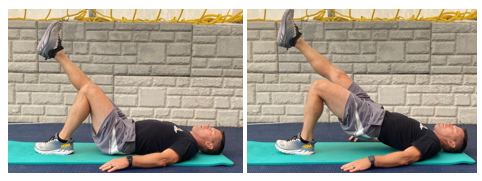
Why this exercise?
The single-leg bridge works abdominals, back, and hip extensors (internal oblique’s, external obliques, rectus abdominus, gluteus maximus, hamstrings, and back extensors).
Procedure:
- Perform abdominal brace (tighten abdomen)
- Extend one knee, so their leg is straight parallel to the thigh.
- Raise hip (buttocks) off the ground. Keep the pelvis from rotating. Isometric hold: Hold this position for 5 seconds.
- Slowly lower the hip without touching the floor. Eccentric: lower for a count of 5 seconds.
- Repeat 5-15 repetitions for 2-3 sets.
- If difficult perform a double leg bridge.
Advanced: Add resistance by placing a weight (dumbbell, kettlebell) on the lower abdomen.
Lunge with Trunk Rotation
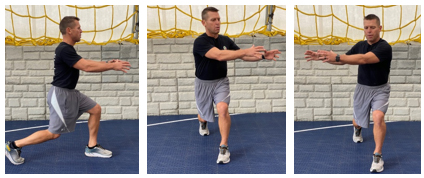
Why this exercise?
The lunge is a great exercise to work the lower extremity. This exercise preferentially works the quadriceps, gluteus maximums, and hamstring muscles in the front leg when in the flexed position. Beyond this, it facilitates the abdominals (rectus abdominus, external oblique, erector spinae) when you add the trunk rotation.
Procedure:
- Take a big step forward, keeping your back straight.
- Slowly lower your body straight down by bending your front knee to about120-100 degrees of flexion, not beyond parallel to the floor. Eccentric: lower to a count of 5 seconds.
- Keep your weight on your back toes and drop the back knee toward the floor. Don’t let the back knee touch the floor. Isometric hold: Hold this position for 5 seconds.
- During this isometric hold, rotate your torso from side to side for 10 reps with arms out.
- Firmly push off with the front leg, activating both your thighs and butt muscles to return to your upright, starting position.
- Repeat on the other side. Perform for 5-10 reps for 2-3 sets.
Advanced: Use a dumbbell or kettlebell while performing the trunk rotations.
Side plank with Leg and Arm Lifts
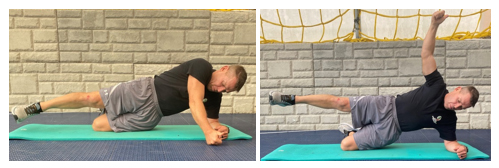
Why this exercise?
This movement is a great core exercise that works multiple muscle groups of the side abdominals (rectus abdominus, tranverse abdominus, external obliques muscles), hips (gluteus medius muscles), and shoulders (deltoid, rhomboid, middle trapezius muscles).
Procedure:
- Position the body in the side plank position on the elbow and knee (or on foot). Keep the top leg straight. Place the arm in front of the body.
- Perform abdominal brace (tighten abdomen) and raise torso and maintain position perpendicular to the ground. Keep the body straight.
- While in the side plank position, raise thigh up (hip abduction), keeping the knee straight, and raise the arm. Isometric hold: Hold this position for 5 seconds.
- Do not allow the torso to rotate forward or backward.
- Slowly lower the arm and leg to the starting position to a count of 5 seconds. Maintain the plank position.
- Repeat the arm and leg movements for 5-10 reps. Perfrorm exercise on the other side. Repeat for 2-3 sets.
Advanced: Use ankle weights, dumbbells, or kettlebell.
Single Leg Squat
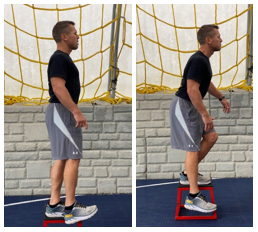
Why this exercise?
Single leg squat (SLS) is an excellent exercise for balance and strengthening of the hips (gluteus medius, gluteus maximus), lower extremity (quadriceps, hamstring), and core musculature (rectus abdominus, internal obliques, transverse abdominus).
Procedure:
- Stand on a step with one leg extended to the side of the stance foot.
- Lower slowly bending the stance leg knee. Eccentric: Lower to a count of 5 seconds. Keep the uninvolved foot in a toe-up (dorsiflexed position).
- The stance leg shin is moving forward over the toes.
- Keep the back straight with abdominal bracing.
- Extending the arms forward helps keep the weight balanced and provide some lateral stability.
- Keep the pelvis level. Control the knee in a straight line without wobbling or swaying.
Advanced: Add weight with a dumbbell or kettlebell held on the uninvolved side.
Front Plank with leg and arm movements

Why this exercise?
The plank is an essential core strengthening exercise. The plank strengthens the abdominals, back, and shoulders. The core helps stabilize the body and allow a transfer of energy as the limbs move.
Procedure:
- Position on elbows and knees (or on toes). Raise torso and maintain position.
- Perform abdominal brace (tighten abdomen)
- Move arm up into a Y position (120 degrees of shoulder abduction). At the same time, raise the thigh (hip extension).
- Slowly lower to the start position. Eccentric: Lower to a count of 5 seconds.
- Repeat arm and leg movements for reps for 5-10 reps while holding the plank position. Perform exercise on the other side. Repeat-2-3 sets.
Advanced: Use ankle weights, dumbbells, or kettlebell
Abdominal Crunch with Trunk Rotation

Why this exercise?
The abdominal crunch with rotation works core muscles (rectus abdominus, transverse abdominus, interal and external obliques. This exercise is essential for improving core stability.
Procedure:
- Raise knee up (hips flexed to 90 degrees). Perform abdominal brace (tighten abdomen).
- Crunch up, raising shoulder blades off the floor. Isometric: Hold this position for 5 seconds.
- Rotate torso from side to side for 10-15 reps.
- Repeat for 2-3 sets.
Advanced: Use medicine ball, dumbbells, or kettlebell while performing the trunk rotations.
If you are in need of a modified holiday home exercise program please don’t hesitate to call Mishock Physical Therapy for a Free Phone Consultation (610)327-2600. Email your questions to mishockpt@comcast.net. Visit our website to learn more about our treatment philosophy, our physical therapy staff, and our 7 convenient locations in Gilbertsville, Skippack, Phoenixville, Boyertown, Limerick, Pottstown, and Steiner Medical.
We can help!
Dr. Mishock is one of only a few clinicians with doctorate-level degrees in both physical therapy and chiropractic in the state of Pennsylvania. He has also authored two books; “Fundamental Training Principles: Essential Knowledge for Building the Elite Athlete”, “ The Rubber Arm; Using Science to Increase Pitch Control, Improve Velocity, and Prevent Elbow and Shoulder Injury” both can be bought on Amazon.

